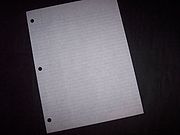
Loose leaf
Encyclopedia

United States
The United States of America is a federal constitutional republic comprising fifty states and a federal district...
, Canada
Canada
Canada is a North American country consisting of ten provinces and three territories. Located in the northern part of the continent, it extends from the Atlantic Ocean in the east to the Pacific Ocean in the west, and northward into the Arctic Ocean...
, and some other countries to describe a piece of notebook paper
Paper
Paper is a thin material mainly used for writing upon, printing upon, drawing or for packaging. It is produced by pressing together moist fibers, typically cellulose pulp derived from wood, rags or grasses, and drying them into flexible sheets....
which is not actually fixed in a spiral notebook
Notebook
A notebook is a book or binder composed of pages of notes, often ruled, made out of paper, used for purposes including recording notes or memoranda, writing, drawing, and scrapbooking....
. In some places, like the United Kingdom
United Kingdom
The United Kingdom of Great Britain and Northern IrelandIn the United Kingdom and Dependencies, other languages have been officially recognised as legitimate autochthonous languages under the European Charter for Regional or Minority Languages...
, the phrase loose leaf refers more to the flexible system of storing loose pages in a binder
Ring binder
Ring binders are folders in which punched pieces of paper may be held by means of clamps running through the holes in the paper...
than to the actual paper.
Typically loose leaf paper has straight blue lines with pink margin
Margin (typography)
In typography, a margin is the space that surrounds the content of a page. The margin helps to define where a line of text begins and ends. When a page is justified the text is spread out to be flush with the left and right margins...
lines. This type of paper is normally sold in packs of 100 or 200 sheets and are not necessarily sold loose which means they can be torn out of notebooks with perforations. Loose leaf generally has three holes so that the piece of paper can fit into a three-ringed binder.
Most of the time, loose leaf paper comes in two types, which are either wide ruled or college ruled. These two types vary such that college ruled paper has less space between the blue lines, allowing for more rows of writing. Wide ruled paper is intended for use by grade school children and those with larger handwriting.
History
Looseleaf serviceLooseleaf service
A looseleaf service is a type of publication used in legal research which brings together both primary and secondary source materials on a specific field or topic in law...
is a form of publishing invented by Richard Prentice Ettinger in 1913, founder of Prentice Hall
Prentice Hall
Prentice Hall is a major educational publisher. It is an imprint of Pearson Education, Inc., based in Upper Saddle River, New Jersey, USA. Prentice Hall publishes print and digital content for the 6-12 and higher-education market. Prentice Hall distributes its technical titles through the Safari...
. As a 19-year-old assistant to his Princeton University
Princeton University
Princeton University is a private research university located in Princeton, New Jersey, United States. The school is one of the eight universities of the Ivy League, and is one of the nine Colonial Colleges founded before the American Revolution....
tax professor he was awarded with the then lucrative task of publishing the professor's book at his own risk. The first print run sold well and he ordered a second print run from an outside printing company. On the very day that this second print run arrived the United States Congress
United States Congress
The United States Congress is the bicameral legislature of the federal government of the United States, consisting of the Senate and the House of Representatives. The Congress meets in the United States Capitol in Washington, D.C....
changed the tax law enough that the book was outdated. Faced with this challenge Ettinger came up with the idea of cutting the pages (leafs) loose, replacing the few pages where changes in the tax code had occurred, drilling holes though the pages and putting them into a ring-binder. Even though it was more costly it did have the added benefit that all future changes of the tax code could easily be accommodated by simply exchanging single leafs.

